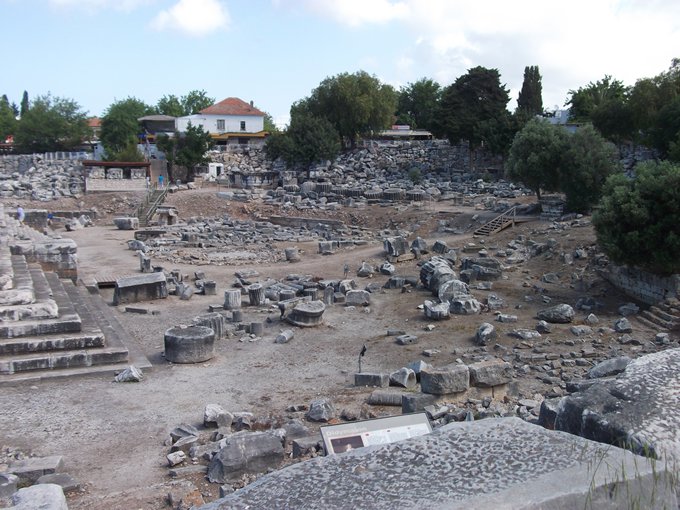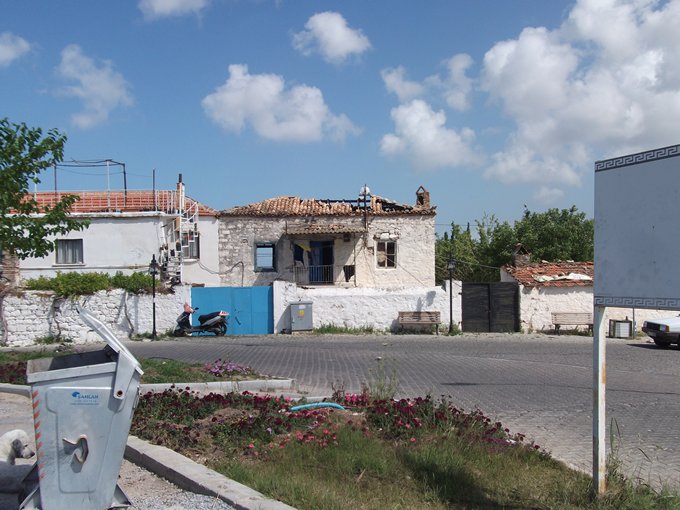Didyma and Ephesus Thursday 15th May, 2014.

Thursday 15th May, 2014.
Ariel was safe and sound in the marina so we hired a car and made our way firstly to Didyma to see the Temple of Apollo built in the 7th century before Christ to honour the god of prophecy and oracles. By 500 BC the shrine was one of the leading oracles of the Greek world. It had a sacred spring and the Branchid priests who were reputedly connected to the order at Delphi were in charge of the shrine. Marble from Lake Bafa which is only a few miles away were used to build the temple. A carved head of Medusa with its serpentine curls was a symbol of Didyma. At its best the Temple of Apollo had 108 Ionic columns but we could only see three. In 1493 the temple was destroyed by an earthquake and Didyma was abandoned. The Ottomans in the 18th century renamed it Yehihisar which means “new castle”.
Didyma is set among run down shacks which people are living in. If it was not so tall you could miss the Temple as so much as been built around it. We left the car and wandered down what appeared to be a high street with a few shops which attracted all the shop keepers who were out trying to sell their wares to us. I took lots of photographs and we wandered around but the whole area needs restoration as the blocks are laid out on the ground and it is impossible to walk around very far. It is fenced off and there were two tills to buy your tickets but to be fair you could see everything from behind the railings. We walked back to the car by a different route and were appalled at the shacks people were living in even worse than the first ones we saw. No windows, broken doors, stoves outside the door and broken roofs.
On our way to Ephesus we stopped to buy strawberries from a stall keeper who was selling her strawberries just by her strawberry field. Juicy strawberries fresh from the field that morning they were delicious. For about £1.10 we had approximately 2.2 pounds of strawberries. Amazing!
We drove along the coast road and headed for Kusadasi which has a big new road being built to take the cars away from the water front but the shop keepers had temporarily lost their shop pavements and it appeared quite impossible for people to get to the shop doors! We decided not to stop and drove on to Ephesus.
Ephesus is much more organised and you pay to park the car, walk through the shop traders selling everything you can think of from fake watches to fake handbags until you reach the tills. You then walk about 200 yards until you can see the wonderful theatre which has had some restoration done by the Austrian government with the approval of the Turkish government. You can imagine the people being sitting in their hundreds listening to the speakers or the gladiators fighting.
Ephesus is one of the greatest ruined cities in the world. A Greek city was built here in about 1000 BC and it is suppose to have been the centre for the worship of Cybele, the Anatolian Mother Goddess. The city we visited was the work of Lysinachus who was Alexander the Great’s successor. Ephesus today is set many miles inland but it use to be surrounded by the sea and was the chief port of the Aegean. As the harbour silted up the city declined but started to spread the word of Christianity. The Virgin Mary is recorded as spending her last few years of her life at Ephesus in AD 37 having been looked after by St. John the Evangelist who travelled from Patmos to do so. According to the Bible Jesus on the crucifix asked John to look after his mother. On the 15th August each year Christians and Muslims visit her very small stone house which is now a shrine.
The city does indeed cover a large area. For us the library of Celsus built in AD 114 to 117 by Gaius Julius Aquila for his father was damaged by an earthquake in 1000 but has fabulous sculpting above its entrances together with four statues. There is Sophia for wisdom, Arete for virtue, Ennoia for intellect and Episteme for knowledge.
The Temple of Hadrian built for his visit in AD 123 has been restored and covered for protection from the elements. The murals restored show that these were indeed houses of very wealthy people who lived in the city. The gate of Hercules leads to Curetes Street where statues lined the road. The Baths of Varius and the Temple of Domitian are both located in the grounds.
As we left Ephesus we looked across to the town of Selcuk which is dominated by a 6th century castle with 15 preserved towers. At the foot of the hill is the Basilica of St. John which is believed to contain the tomb of St. John the Evangelist. Nearby now waterlogged is the Temple of Artemis which was one of the Seven Wonders of the Ancient World. There is an amazing amount of history in one small area.
This area is now part of the Menderes River Valley which is one of Turkey’s main grain growing regions and producer of fruit.
We stopped in Kusadasi on the way back to look at the marina. The promenade which has been built high like a bridge to overlook the marina and bay is planted with cactus while underneath there are very exclusive shops and restaurants.
Next we stopped at the Kipa hypermarket which is Tesco’s Turkish outlet. It was funny to see the F& F range of clothing hanging on the rails. It is quite a new shop with only a few customers and we only heard English voices around us! We couldn’t imagine some of the local families we had spotted while driving during the day could afford the supermarket prices.
We ended our day back in Altinkum at a lovely restaurant overlooking the bay for dinner and the very important wifi!














